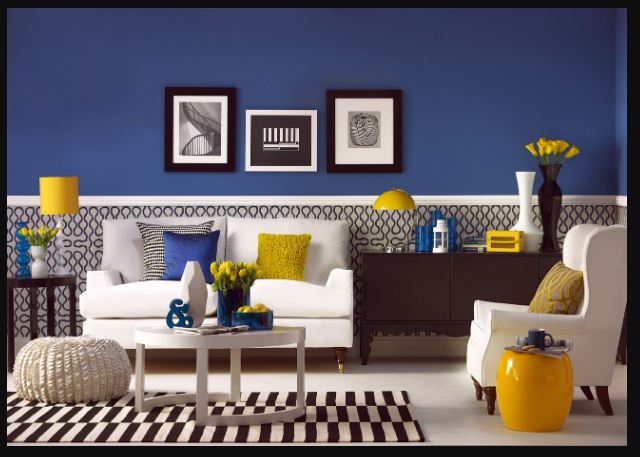Introduction to the Psychology of Color
Colour is a powerful tool in interior design, evoking emotions, influencing perceptions, and shaping experiences. From the soothing blue of a tranquil bedroom to the vibrant red of a lively living room, the choice of colours in a space can profoundly impact its occupants.
This article delves into the fascinating world of colour psychology and its application in interior design.
The Basics of Color Theory
Before exploring the psychological aspects of colour, it’s essential to understand the fundamentals of colour theory. Colours are classified into primary (red, blue, yellow), secondary (orange, green, purple), and tertiary (red-orange, yellow-green, blue-purple) categories.
Additionally, colours can be categorized as warm (red, orange, yellow) or cool (blue, green, purple), each with unique characteristics and associations.
Emotional Associations of Colors
Colours evoke various emotions and associations, each carrying its symbolic meaning. Red, for example, is often associated with passion and energy, while blue conveys a sense of serenity and calmness.
Green symbolizes harmony and growth, yellow exudes optimism and happiness, purple signifies luxury and creativity, and orange radiates warmth and enthusiasm.
Practical Applications in Interior Design
Understanding the emotional associations of colours enables designers to create spaces that evoke specific moods and atmospheres.
For instance, a bedroom adorned in calming shades of blue promotes relaxation and restful sleep, while a kitchen painted in vibrant yellow hues energizes and uplifts the mood of its occupants.
By carefully selecting colours for different spaces, designers can tailor the ambience to suit the room’s intended purpose.
Cultural and Contextual Influences
It’s essential to consider cultural and contextual influences when incorporating colour into interior design. Different cultures may have varying perceptions and associations with colours, necessitating sensitivity to local preferences and customs.
What may be considered auspicious in one culture may carry negative connotations in another, highlighting the importance of adapting colour choices to the specific context of the design project.
Colour Combinations and Harmonies
In addition to individual colours, combining colours within a space is crucial in creating visual interest and harmony.
Designers often employ colour schemes such as monochromatic (using variations of a single colour), analogous (using colours adjacent to each other on the colour wheel), and complementary (using colours opposite each other on the colour wheel) to achieve balance and cohesion in their designs.
Psychological Effects on Behavior
The psychological effects of colour extend beyond aesthetics, influencing behaviour and cognitive processes. Studies have shown that specific colours can enhance productivity and creativity, while others may stimulate appetite or promote relaxation.
Understanding these effects allows designers to use colour strategy to create environments supporting specific activities and behaviours
Case Studies: Successful Use of Color
Numerous examples of well-designed spaces effectively utilize colour to enhance the user experience. From the vibrant hues of Google’s offices to the serene palettes of luxury spas, each space demonstrates the transformative power of colour in shaping perceptions and emotions.
By analyzing these case studies, designers can gain valuable insights into the effective use of colour in interior design.
Challenges and Considerations
While colour can profoundly impact the ambience of a space, designers must navigate various challenges and considerations when incorporating colour into their designs.
Personal preferences, individual reactions to colour, and cultural sensitivities play a role in the design process, necessitating a thoughtful and nuanced approach to colour selection.
Future Trends and Innovations
As technology advances and design trends evolve, the future of colour in interior design holds endless possibilities. From interactive lighting systems to customizable colour palettes, innovations in colour technology are poised to revolutionize how we experience and interact with interior spaces.
By staying abreast of emerging trends and incorporating psychological principles into their designs, designers can create spaces that resonate deeply with their occupants.
Conclusion
In conclusion, the psychology of colour is a multifaceted and dynamic field with profound implications for interior design.
By harnessing the emotional power of colour and understanding its effects on behaviour and perception, designers can create spaces that look beautiful and feel harmonious and inviting.
As we continue to explore the intersection of colour psychology and design, let us embrace the transformative potential of colour to elevate the human experience.
FAQs (Frequently Asked Questions)
How does colour affect mood in interior design?
Depending on their psychological associations, colours can evoke specific emotions and moods, such as calmness, energy, or happiness.
Are there cultural differences in colour perception?
Yes, different cultures may have varying perceptions and associations with colours, highlighting the importance of considering cultural context in design.
What are some common colour combinations used in interior design?
Monochromatic, analogous, and complementary colour schemes create visual interest and harmony in interior design.
How can colour be used to enhance productivity in workspaces?
Specific colours, such as shades of blue and green, have been shown to promote focus and productivity, making them ideal choices for work environments.
What factors should be considered when selecting colours for interior spaces?
Designers should consider the space’s purpose, its occupants’ preferences, and cultural influences when selecting colours for interior spaces.
Latest Post!
- Extend Your Living Space: Functional and Stylish Outdoor Deck Ideas

- From Concrete to Asphalt: Exploring Different Driveway Paving Options

- The Hidden Dangers of Drywood Termite Holes and Droppings in Your Home

- How Fast House Buyers Can Help You Sell Your Home in Record Time

- Transform Your Outdoor Space: Stamped Concrete Patio Ideas and Inspiration

- The Benefits of Hiring an HVAC Specialist to Fix Your Broken Aircon



